
What Is Time Management In SAP HR?
Last updated on 13th Oct 2020, Artciles, Blog
SAP HR – Time Management (TM)
Time management (TM) sub-modules of SAP HR offer functionality to record attendances and absences for employees shift/ workforce planning, shift administration, time evaluation (attendances, absences, overtime, bonus, wages), etc.
In the core SAP HR process, the time management department will have the following functions.
Subscribe For Free Demo
Error: Contact form not found.
- 1.Time recording
- 2.Leave management
- 3.Attendance management
- 4.Time data collection for payroll run
Time Recording :
Recording of Clock in or Clock out or number of working hours on a specific day is called as time recording. The main purpose of recording time is to ensure the correct tracking of all employees’ time related data for the payroll process. Time recording process can be divided into two types.
- Positive time recording – It captures employees actual working hours / time.
- Negative time recording – It captures employees absences against planned working hours. For e.g. Working hours: 8:30 AM to 6:00 PM, Absence: 1:30 PM to 6:00 PM.
Leave Management :
Leaves are divided into two types i.e.
- Paid leaves:– When the employees are on leave, they will get the salary based on the paid leaves. For e.g. Annual leave, sick leave, Maternity leave, etc.
- Unpaid leaves:– No payment will be done when employees are on unpaid leaves.
Attendance management :
Attendance management can be divided into two types
- Planned working hours – It is also called a work schedule, it specifies the number of hours an employee should work on a particular day.
- Actual working hours : – If an employee works on public holidays, weekdays, so the employees can avail compensatory time off or extra payment allowances.
Time data collection :
Time data can be collected by integration with the time department, attendance department and leave department. After collection of time data, it can be run on payroll.
Important Configuration of Time Management in SAP HR
The important configuration steps of time management SAP HR module are as follows.
- 1.Work schedules
- 2.Time data recording and administration
- 3.Personnel time events
- 4.Plan data collections
- 5.Time evaluation
- 6.Time managers workplace
- 7.Integration of time management with other SAP applications
- 8.Shift planning
- 9.Incentive wages
- 10.Management of roles and authorizations
- 11.Information systems
- 12.Web applications.
SAP time management is a module under SAP HR management, which is used by employees for time tracking and management across departments. Time management is one of the main components in any organization as it is necessary to maintain time along with the work performed. This helps an organization to calculate profit and loss, human costs, track time booking in a project, etc.
The key features of SAP Time management are −
- Monitors Human Costs as per time booking for a project.
- Documents Progress of Process.
- Process of Invoices.
- Records External Employees’ Services.
- Maintains Planning and Progress.
- Confirms Service Management Orders.
- Collects Data Plans and Sheets.
Advantages of Time Management
The main advantages or tasks that are performed under SAP Time management are as follows −
- Time Recording and Evaluation.
- Negative & Positive Time Recording.
- Work schedules & work schedules Rules.
- Public holiday Calendar, counting rules.
- Attendance Absences.
- Shift Management in HR.
- Overtime and Breaks Schedules under Time Management.
Time Recording and Evaluation
There are various types of time recordings that can be performed in Time management system i.e. number of hours worked in a project, leave and absence, holidays, business trips, etc.
You can book two types of absences in Time management −
- Quota driven absences − This absence type includes the leave taken from the allocated limit in a specific time period. Example: Casual Leaves, Earned Leaves.
- Non quota driven absences − This absence type includes all unplanned leaves and are not a part of allocated limit in a time frame. Example: Leave without pay, Study leave. Etc.
Various Infotypes are defined in SAP system for time recording −
| Absences | 2001 |
| Attendance | 2002 |
| Overtime | 2005 |
| Absence – Quota Driven | 2006 |
| Attendance – Quota Driven | 2007 |
| Time Events | 2011 |
Transaction Codes for Time Recording
Time Data Maintenance: PA61

Time Data Display: PA51
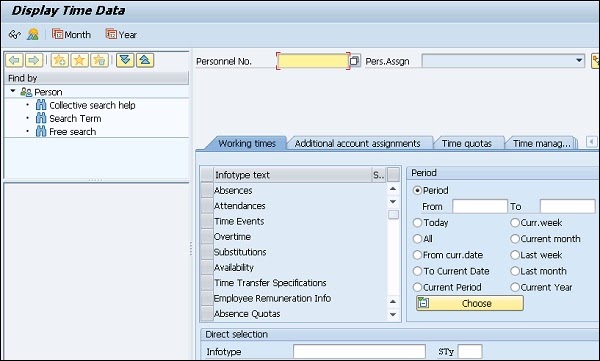
Calendar Entry: PA64
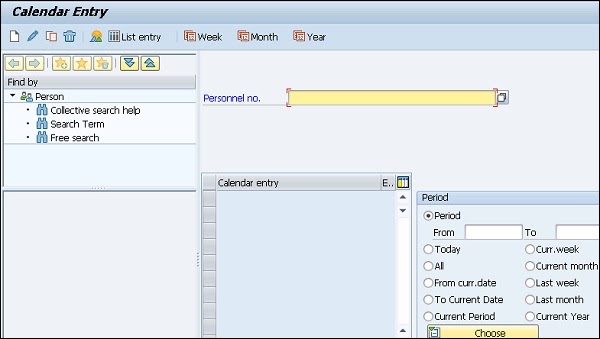
To maintain the list entry of data: PA62
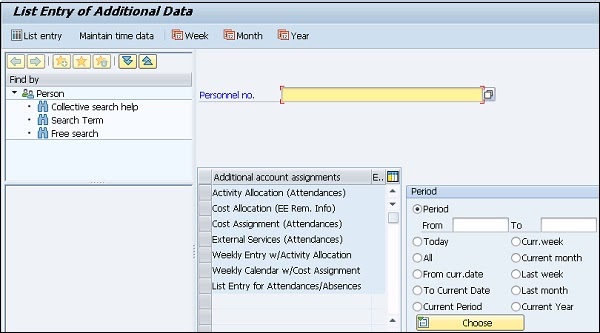
Time Evaluation
Time evaluation is used to record the attendance of an employee and to record hisTime_evaluation absence from work. Time recording is required to process the payroll. Time evaluation is run for specific employees and all the employees are not required to process time evaluation.
Step 1−
To run time evaluation, use T-code: PT60.

Step 2−
A new window will open, HR Time: Time Evaluation.
Enter details like Personnel Number, Evaluation Schema and Evaluation up to.
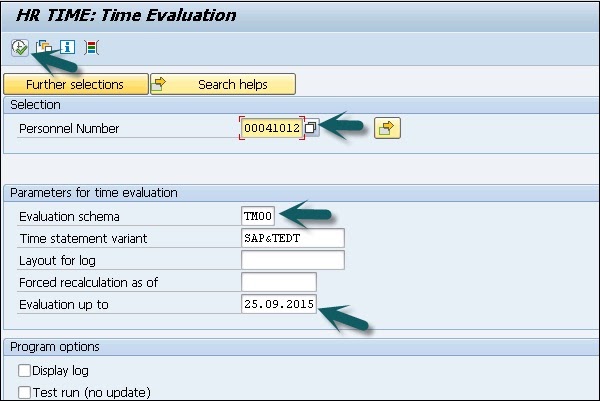
Step 3−
Click Execution. Time will be evaluated and log is displayed.
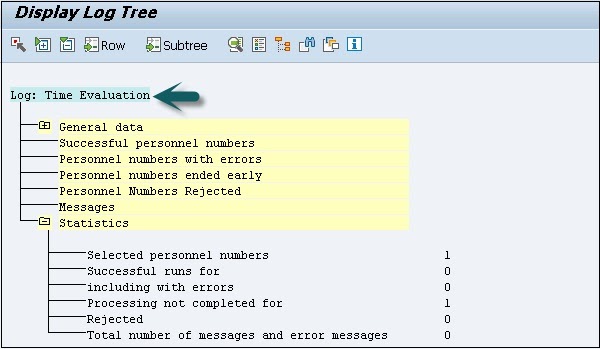
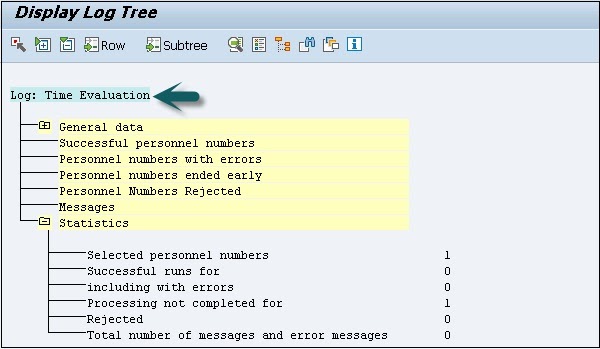
Positive Time Recording
Positive Time recording plays an important role in the workflow. All the processes related to time are executed automatically in the background.
The key features are −
- In positive time recording, you can record two types of time −
- With Clock time − In this type of time recording, full time recording is captured.
- Without Clock time − It includes capturing only the number of works hours.
- Positive time recording is difficult to implement as you need to define each type of attendance.
- Positive time recording deals with daily attendance, absence and over time.
Negative Time Recording
Negative Time recording includes all the time related activities like posting of absence for wage deduction, attendance validation etc. are performed manually.
The key features are −
- It has less level of integration among the different components of time management.
- Negative time recording includes no clock times and assumes employee is working until absences are entered.
- Negative time recording reads deviation like absence, comp off, overtime, etc.
Are you looking training with Right Jobs?
Contact Us- What is SAP Certification?
- SAP Financials And SAP Accounting Modules
- Certified Information Systems Security Professional (CISSP) Certification
- What Is SAP Human Capital Management (HCM)?
- Togaf Interview Questions and Answers
Related Articles
Popular Courses
- Oracle Training
11025 Learners - Workday Training
12022 Learners - SAP Training
11141 Learners
- What is Dimension Reduction? | Know the techniques
- Difference between Data Lake vs Data Warehouse: A Complete Guide For Beginners with Best Practices
- What is Dimension Reduction? | Know the techniques
- What does the Yield keyword do and How to use Yield in python ? [ OverView ]
- Agile Sprint Planning | Everything You Need to Know
